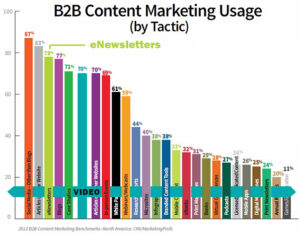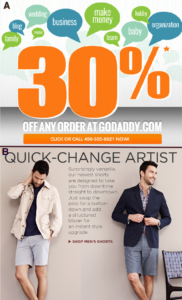
This the third in a series about integrating video with your other email marketing tactics. Here is why your eNewsletter should link to videos
The word “video” in the subject line increases click rates by 65%
That’s according to a 2013 MarketingProfs study. This is good news for technology marketers, most of whom produce video, and few of whom can use “free delivery” — which scores 135% — in their email subject lines.
Video can make your call-to-action a no-brainer
Subscribers to eNewsletters vary greatly on where they are in the decision process — not just how much they know or care about you and your product or service, but also what they actually need. In any case, many will be very uncertain whether they should put any more time and effort into finding out what you can do for them. Video in your eNewsletter can reduce that uncertainty, because viewing a short video is the most painless way to determine your own level of interest in something.
So, a video “trailer” for your webinar, or a video touting “five cool things you can do with our free thing-y” will certainly can turn that decision on whether to take the next step into a very easy decision. Then you should consider making it easy to act on that easy decision by embedding the CTA right in the video window.
You can match video segmentation to email segmentation
Many marketers segment their eNewsletters. Too few segment their videos. It’s not at all difficult to snip segments from video testimonials, process animations, demos, or executive presentations so they speak to specific segments of your e-newsletter lists. They could be excerpts inviting the viewer to watch the whole thing. Or they could just be nuggets of helpful information.
You can feature benefits more persuasively
To many of us who work in information technology, a cool feature is a benefit. But of course it’s not, really. I’ve never seen the difference between features and benefits more clearly or cleverly explained than Corey Eridon does in this listicle for Hubspot.

The question is, which of these two email ads is about benefits? My first thought was that 30% off looks like a benefit, Wrong. Oh well, I’m not shopping for shorts. If I were, I should have immediately seen that the benefit of these shorts is versatility. And the benefit of 30% an order at GoDaddy is — what? I would have to figure out the tangible benefit —lowering infrastructure costs, or whatever — for myself.
But how does this apply to enterprise technology? The benefits are tangible (productivity, cost reduction, faster time-to-market) but usually not easy to illustrate as clearly as this ad does it. (Sure, charts can be persuasive, but company lawyers usually insist on qualifying promises, not quantifying them. )
Video is great for illustrating features, though — features that can be hard to describe in words. Here’s one way I recommend putting across technology benefits in an eNewsletter: put the benefit in the headline and the underlying feature in a video (“Watch this 10-second video to see just one of the ways you can reduce software licensing costs!”).



